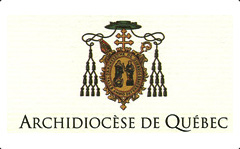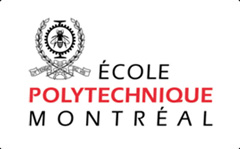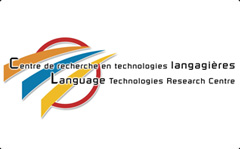We express our gratitude towards our contributors and towards Canadian Heritage for its partnership:
The “Virtual Cathedral” exhibit and the launching of “Archives Virtuelles” have been made possible thanks to the expert contribution and support of a remarkable team of archivists, researchers and professors.
We wish to thank the following persons for their participation (listed in alphabetical order):
o The ARCHDIOCESE OF QUÉBEC ARCHIVES OFFICE provided remarkable expertise in analyzing the documents submitted. The Archdiocese of Québec archivist Father Armand GAGNÉ transcribed and translated the Latin apostolic document Transumptum Bullarum. Father Gagné and Pierre LAFONTAINE, assistant archivist at the Archdiocese of Québec, revised and validated the texts and comments.
o Daniel COGNÉ teaches literature at the Cégep de l'Outaouais and is Fellow and Past Vice-President of the Royal Heraldry Society of Canada. He was editor of the magazine “L'Héraldique au Canada-Heraldry in Canada” from 1991 to 1995, curator of the exhibit “Lasting Impressions: Seals in our History”, National Archives of Canada, 1991 and is an associate member of the International Academy of Heraldry.
o Jean-François COTTIER is a full professor in the Department of French Literature and Director of the Centre d’études médiévales at the Université de Montréal. He is also a specialist in Latin literature of the Middle Ages and the Renaissance, and a researcher funded by the Social Sciences and Humanities Research Council of Canada for his studies of the Latin heritage of Québec.
o Lorraine GADOURY has been archivist at Library and Archives Canada since 1991. She has a PhD in history and is a specialist in the history of New France. She is the author of numerous articles and publications relating to, among other things, the demography and family of New France.
o Jean-Philippe GARNEAU is a professor at the Université du Québec à Montréal and a specialist in the history of law, particularly in Quebec society before 1867. His work focuses specifically on the social and cultural history of law and justice.
o Léo-Paul HÉBERT is a priest and cleric of Saint-Viateur. He has taught at the Cégep de Joliette and worked as a historian and researcher. He has two PhDs, one in literature (Sorbonne) and the other in history (Paris IV). He is the author of about 15 volumes and some 30 articles on the Amerindian peoples. He annotated, transcribed and translated Mort précieuse and transcribed and wrote commentary on the Registre de Sillery.
o Gilles HÉON has been linked to the world of archives since 1969 when he joined the Archives nationales du Québec and became a member of the Association des archivistes du Québec. He retired from the Archives nationales du Québec in October 2004 and has since worked as archivist-advisor with the city of Quebec and now works with the Roman Catholic Archdiocese of Quebec City. He is the author of numerous texts in magazines dealing with archives. In recent years, he has written a series of observations on the future of religious archives in Quebec.
o Pierre ISABELLE is currently a Principal Scientist with the National Research Council, where he has managed the Interactive Language Technologies Group of the Institute for Information Technology since January 2005. Dr. Isabelle holds a PhD in linguistics from the Université de Montréal. He has devoted his long career to doing and managing research in language technology. Before joining the NRC, he has worked as: researcher and Scientific director of the TAUM group of automated translation (Université de Montréal); manager of the Machine-Assisted Translation group of the CITI Laboratory (Industry Canada); founder and manager of the RALI laboratory (Université de Montréal); and manager of the Content Analysis Group of the Xerox Research Centre Europe Laboratory (Grenoble).
o Danielle LORD, museologist and art historian, has worked for various Canadian institutions as a curator and writer of historical commentary and technical descriptions of religious art.
o Christiane MELANÇON is a full professor at the Université du Québec en Outaouais, where she has been a professor since 1993. She contributed directly to the development of the Department of Language Studies which, in just a few years, allowed the Université du Québec en Outaouais to become the third most important translation training institution in Canada. Ms. Melançon was a key person in the establishment of the Language Technologies Research Centre, whose mission is to carry out and promote research development and technology transfer activities in language technologies. An author of numerous scholarly journals, she has worked in a number of research and teaching fields, and she was the president of the Conseil international d'études francophones from 2007 to 2009.
o Luc NOPPEN – Canada Research Chair on Urban Heritage at the Université du Québec à Montréal and specialist in the architectural evolution of the Notre-Dame de Québec basilica-cathedral. He permitted and facilitated the use of images from his beautiful book Notre-Dame de Québec : son architecture et son rayonnement (1647-1922), Éd. du Pélican (1974).
o Réjean PLAMONDON is a full professor in the Department of Electrial Engineering at the École Polytechnique de Montréal where he is director of the Scribens laboratory, a group conducting research on automated processing of manuscripts. Various applications are currently under study: automatic signature verification, writing recognition, writing learning, analysis of fine motor skills, and document preprocessing.
o Rémi SAVARD was referred as an expert by Ghislain PICARD, the Chief of the Assembly of First Nations of Quebec. After completing a Master’s Degree in Sociology from Laval University (Quebec City, 1960) and a Doctorate in Ethnology from the École Pratique des Hautes Études (Sorbonne, Paris 1964), Rémi Savard taught at the Department of Anthropology of the Université de Montréal until the end of 2001, except for a five-year period (1969-1974) when he was employed by Laval University. His teaching has been influenced by his research into communities whose land and natural resources were appropriated by descendants of colonists from Europe in the mid-19th century.
PROJECT MANAGEMENT: As creator of the “Virtual Archives” electronic publishing project, Marie GRÉGOIRE designed and produced the “Virtual Cathedral” exhibit by establishing links among the heads of several major institutions and distinguished participants and specialists. Her goal in designing the “Virtual Archives” project was to provide electronic publishing of historical documents and greater access to these documents. professor associated with the Department of History of the Université de Sherbrooke. She has a PhD in History-Archeology from École Pratique des Hautes Études, Sorbonne à Paris..
DESIGN: The PAKOBRATS firm provided graphic design for the virtual exhibit’s Web site. William SULLIVAN created and developed graphic interfaces and was the Web site programmer.
Jérémie GÉRARD-DUCHESNE, social sciences student at the Université du Québec en Outaouais, worked as research assistant.
For the splash page of this Web site, we are grateful to Les éditions du SEPTENTRION for their permission to reproduce the “Map of New France” (attributed to Jean-Baptiste Franquelin, around 1708), from the atlas by Raymonde Litalien, Jean-François Palomino and Denis Vaugeois, La mesure d’un continent, (Mapping a Continent: Historical Atlas of North America, 1492-1814 in English), Les éditions du Septentrion, 2008.
We wish to thank the following persons for their participation (listed in alphabetical order):
o The ARCHDIOCESE OF QUÉBEC ARCHIVES OFFICE provided remarkable expertise in analyzing the documents submitted. The Archdiocese of Québec archivist Father Armand GAGNÉ transcribed and translated the Latin apostolic document Transumptum Bullarum. Father Gagné and Pierre LAFONTAINE, assistant archivist at the Archdiocese of Québec, revised and validated the texts and comments.
o Daniel COGNÉ teaches literature at the Cégep de l'Outaouais and is Fellow and Past Vice-President of the Royal Heraldry Society of Canada. He was editor of the magazine “L'Héraldique au Canada-Heraldry in Canada” from 1991 to 1995, curator of the exhibit “Lasting Impressions: Seals in our History”, National Archives of Canada, 1991 and is an associate member of the International Academy of Heraldry.
o Jean-François COTTIER is a full professor in the Department of French Literature and Director of the Centre d’études médiévales at the Université de Montréal. He is also a specialist in Latin literature of the Middle Ages and the Renaissance, and a researcher funded by the Social Sciences and Humanities Research Council of Canada for his studies of the Latin heritage of Québec.
o Lorraine GADOURY has been archivist at Library and Archives Canada since 1991. She has a PhD in history and is a specialist in the history of New France. She is the author of numerous articles and publications relating to, among other things, the demography and family of New France.
o Jean-Philippe GARNEAU is a professor at the Université du Québec à Montréal and a specialist in the history of law, particularly in Quebec society before 1867. His work focuses specifically on the social and cultural history of law and justice.
o Léo-Paul HÉBERT is a priest and cleric of Saint-Viateur. He has taught at the Cégep de Joliette and worked as a historian and researcher. He has two PhDs, one in literature (Sorbonne) and the other in history (Paris IV). He is the author of about 15 volumes and some 30 articles on the Amerindian peoples. He annotated, transcribed and translated Mort précieuse and transcribed and wrote commentary on the Registre de Sillery.
o Gilles HÉON has been linked to the world of archives since 1969 when he joined the Archives nationales du Québec and became a member of the Association des archivistes du Québec. He retired from the Archives nationales du Québec in October 2004 and has since worked as archivist-advisor with the city of Quebec and now works with the Roman Catholic Archdiocese of Quebec City. He is the author of numerous texts in magazines dealing with archives. In recent years, he has written a series of observations on the future of religious archives in Quebec.
o Pierre ISABELLE is currently a Principal Scientist with the National Research Council, where he has managed the Interactive Language Technologies Group of the Institute for Information Technology since January 2005. Dr. Isabelle holds a PhD in linguistics from the Université de Montréal. He has devoted his long career to doing and managing research in language technology. Before joining the NRC, he has worked as: researcher and Scientific director of the TAUM group of automated translation (Université de Montréal); manager of the Machine-Assisted Translation group of the CITI Laboratory (Industry Canada); founder and manager of the RALI laboratory (Université de Montréal); and manager of the Content Analysis Group of the Xerox Research Centre Europe Laboratory (Grenoble).
o Danielle LORD, museologist and art historian, has worked for various Canadian institutions as a curator and writer of historical commentary and technical descriptions of religious art.
o Christiane MELANÇON is a full professor at the Université du Québec en Outaouais, where she has been a professor since 1993. She contributed directly to the development of the Department of Language Studies which, in just a few years, allowed the Université du Québec en Outaouais to become the third most important translation training institution in Canada. Ms. Melançon was a key person in the establishment of the Language Technologies Research Centre, whose mission is to carry out and promote research development and technology transfer activities in language technologies. An author of numerous scholarly journals, she has worked in a number of research and teaching fields, and she was the president of the Conseil international d'études francophones from 2007 to 2009.
o Luc NOPPEN – Canada Research Chair on Urban Heritage at the Université du Québec à Montréal and specialist in the architectural evolution of the Notre-Dame de Québec basilica-cathedral. He permitted and facilitated the use of images from his beautiful book Notre-Dame de Québec : son architecture et son rayonnement (1647-1922), Éd. du Pélican (1974).
o Réjean PLAMONDON is a full professor in the Department of Electrial Engineering at the École Polytechnique de Montréal where he is director of the Scribens laboratory, a group conducting research on automated processing of manuscripts. Various applications are currently under study: automatic signature verification, writing recognition, writing learning, analysis of fine motor skills, and document preprocessing.
o Rémi SAVARD was referred as an expert by Ghislain PICARD, the Chief of the Assembly of First Nations of Quebec. After completing a Master’s Degree in Sociology from Laval University (Quebec City, 1960) and a Doctorate in Ethnology from the École Pratique des Hautes Études (Sorbonne, Paris 1964), Rémi Savard taught at the Department of Anthropology of the Université de Montréal until the end of 2001, except for a five-year period (1969-1974) when he was employed by Laval University. His teaching has been influenced by his research into communities whose land and natural resources were appropriated by descendants of colonists from Europe in the mid-19th century.
PROJECT MANAGEMENT: As creator of the “Virtual Archives” electronic publishing project, Marie GRÉGOIRE designed and produced the “Virtual Cathedral” exhibit by establishing links among the heads of several major institutions and distinguished participants and specialists. Her goal in designing the “Virtual Archives” project was to provide electronic publishing of historical documents and greater access to these documents. professor associated with the Department of History of the Université de Sherbrooke. She has a PhD in History-Archeology from École Pratique des Hautes Études, Sorbonne à Paris..
DESIGN: The PAKOBRATS firm provided graphic design for the virtual exhibit’s Web site. William SULLIVAN created and developed graphic interfaces and was the Web site programmer.
Jérémie GÉRARD-DUCHESNE, social sciences student at the Université du Québec en Outaouais, worked as research assistant.
For the splash page of this Web site, we are grateful to Les éditions du SEPTENTRION for their permission to reproduce the “Map of New France” (attributed to Jean-Baptiste Franquelin, around 1708), from the atlas by Raymonde Litalien, Jean-François Palomino and Denis Vaugeois, La mesure d’un continent, (Mapping a Continent: Historical Atlas of North America, 1492-1814 in English), Les éditions du Septentrion, 2008.
 Virtual Archives
Virtual Archives




